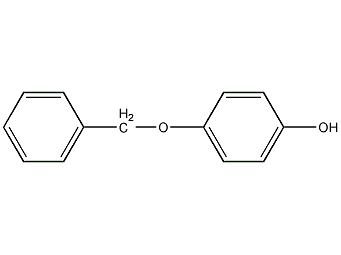4-Benzyloxyphenol 4-Benzyloxyphenol


Structural formula
| Business number | 02MZ |
|---|---|
| Molecular formula | C13H12O2 |
| Molecular weight | 200.24 |
| label |
Hydroquinone monobenzyl ether, Hydroquinone monobenzyl ether |
Numbering system
CAS number:103-16-2
MDL number:MFCD00002333
EINECS number:203-083-3
RTECS number:SJ7700000
BRN number:1958305
PubChem number:24849729
Physical property data
1. Properties: light brown solid.
2. Density (g/mL, 20℃): Undetermined
3. Relative vapor density (g/mL, air=1): Undetermined
4. Melting point (ºC): 119-120
5. Boiling point (ºC, normal pressure): Undetermined
6. Boiling point (ºC, 5mmHg): Undetermined
7. Refractive index: Undetermined
8. Flash point (ºC): Undetermined
9. Specific rotation (º): Undetermined
p>
10. Autoignition point or ignition temperature (ºC): Not determined
11. Vapor pressure (mmHg, 20ºC): Not determined
12. Saturated vapor pressure (kPa, 20ºC): Undetermined
13. Heat of combustion (KJ/mol): Undetermined
14. Critical temperature (ºC): Undetermined
15. Critical pressure (KPa): Undetermined
16. Log value of oil-water (octanol/water) distribution coefficient: Undetermined
17. Explosion upper limit (%, V /V): Undetermined
18. Lower explosion limit (%, V/V): Undetermined
19. Solubility: Slightly soluble in cold water, easily soluble in hot water, Most organic solvents such as acetone.
Toxicological data
1. Skin/eye irritation: Standard Dresser test: guinea pig skin contact, 5%/48 HREACTION SEVERITY, mild reaction; 2. Acute toxicity: rat peritoneal cavity LD50: 4500mg/kg; mouse peritoneal cavity LD50: >600mg /kg; 3. Chronic toxicity/carcinogenicity: Mouse oral TDLo: 163mg/kg/78W-I; Mouse subcutaneous TDLo: 1000mg/kg;
Ecological data
This substance is slightly hazardous to water.
Molecular structure data
1. Molar refractive index: 59.30
2. Molar volume (cm3/mol): 172.5
3. Isotonic specific volume (90.2K ): 451.1
4. Surface tension (dyne/cm): 46.6
5. Dielectric constant:
6. Dipole moment (10-24cm3):
7. Polarizability: 23.50
Compute chemical data
1. Reference value for hydrophobic parameter calculation (XlogP): None
2. Number of hydrogen bond donors: 1
3. Number of hydrogen bond acceptors: 2
4. Number of rotatable chemical bonds: 3
5. Number of tautomers: 2
6. Topological molecule polar surface area 29.5
7. Number of heavy atoms: 15
8. Surface charge: 0
9. Complexity: 167
10. Number of isotope atoms: 0
11. Determine the number of atomic stereocenters: 0
12. Uncertain number of atomic stereocenters: 0
13. Determine the number of chemical bond stereocenters: 0
14. Number of uncertain chemical bond stereocenters: 0
15. Number of covalent bond units: 1
Properties and stability
Avoid contact with strong oxidants and strong alkali.
Storage method
Store in a cool, ventilated warehouse. Keep away from fire and heat sources. They should be stored separately from oxidants and alkalis, and avoid mixed storage. Equipped with the appropriate variety and quantity of fire equipment. Suitable materials should be available in the storage area to contain spills.
Synthesis method
None yet
Purpose
Used as antioxidant in rubber industry.
